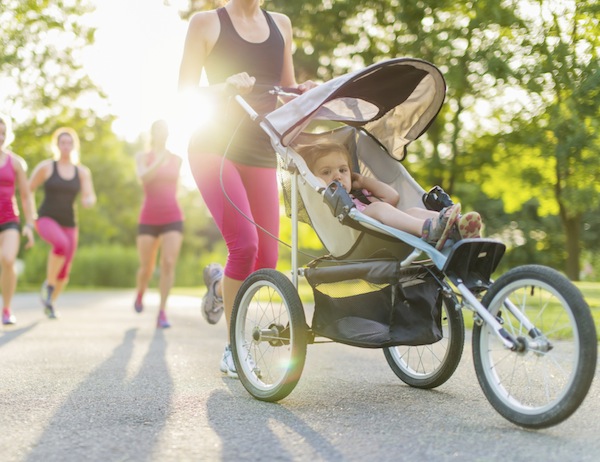
As a pre and postnatal exercise specialist and mother of two baby boys, I understand how anxious you may feel about getting back into shape post-pregnancy. Here’s what, as moms, we need to remind ourselves of: Recovering from pregnancy and labor is like recovering from an injury or surgery. It takes time, patience and dedication.
Postnatal women constantly reach out to me and ask what they can do until their doctor gives them the green light to go back to exercising. If you are feeling anxious about your post-baby body and are starting to think about exercising again, you may not like my answer: DO NOTHING. If the person who helped you deliver your baby tells you not to push a stroller for four weeks or carry anything heavier than the weight of your baby or not to go up the stairs, then DON’T do it. Your OBGYN, or midwife, guided you through your pregnancy and was an active participant in your labor. They witnessed what happened to your body in the process, so it’s in your best interest to listen to them. I promise!
Overall, if what your doctors are saying sounds too good to be true, there’s always a chance it is, or perhaps they don’t have all the information they need from you. After I had my first son, Landon, I went in for my four-week checkup, and my OBGYN said, “You look fine. Do whatever feels good.” My hope is that she just assumed that because I’m considered an expert in my field, I knew what would be appropriate in the beginning weeks. But what concerns me is that this might be the advice she gives to every new mom who looks “fine” at their four-week checkup. Clearly, she did not know the fitness regimen I was used to or she would have never said “do whatever.” (By the way, I changed OBGYNs for the birth of my second son.) My point is, if your doctor does not specify what you should and should not do, you may want to tell them exactly what you have in mind and get their opinion.
Once you get approval to move forward with a fitness program again, there are a few things you need to be aware of and check yourself for so that you aren’t working your core in a way that is going to cause more damage than good. Your doctor may or may not check for these things, so it’s always good to ask.
The first thing to be on the lookout for is a diastasis recti, which is when the abdominals separate too much during your pregnancy. You can check yourself or have someone assist you. You can even test yourself during your pregnancy, as I demonstrate in my YouTube video HERE.
I suggest performing the “finger test” post-baby for a more accurate read, which I also demonstrate in the video. If you find that you have one, you must be extremely careful and aware of your core movements. You’ll want to avoid exercises like crunches, cat/cow, and up dog along with others as they are counterintuitive to what you are trying to do - bring your abdominal muscles back together. It is important that you inspect your body for this because if your separation is too big it is possible for a hernia can occur.
It is also imperative to be mindful of how you carry and support yourself (and your children) throughout the day. Here are some of the core exercises that I do throughout my day to avoid letting my belly pooch out into what I call a Buddha Belly. These exercises are great because they are safe for a recovering diastasis recti and don’t require a scheduled workout.
Another common issue that is often overlooked is a pelvic organ prolapse. This occurs when a pelvic organ-like your bladder, uterus or bowel-drops (or prolapses) from it’s normal place and pushes against the walls of your vagina, and in some severe cases protrudes. It can often happen due to strain during childbirth. Some studies have shown that pelvic organ prolapse occurs in up to 40% of women. If you find that you have a prolapse, you are going to want to avoid high-impact exercises and practice kegel exercises daily.
The last and most important thing for you to do in your postnatal recovery is to LISTEN TO YOUR BODY. If you are feeling like something just doesn’t feel right, remember that you know your body better than anyone else. In order to really make sure you are in a healthy and safe place to begin exercising, I suggest the following:
1) Get a referral from your OBGYN or midwife. Request a pelvic floor specialist or physical therapist who can help diagnose both a diastasis recti and prolapse.
2) Seek a second opinion of necessary. If you feel like your OBGYN or midwife isn’t giving you good advice, then seek a second opinion from another doctor.
3) Ease back into your exercise routine slowly. My new postnatal workout program - Expecting MORE: The 4th Trimester Workout, includes 8 different workouts and a calendar, that will help guide you back into your fitness regiment.
4) Seek out a pre or postnatal certified trainer or take a postnatal exercise class. Working with someone who has experience in postnatal exercise will help keep you safe and recognize the areas of the body that need the most attention post-pregnancy.
I hope that these tips help you as you ease back into an exercise regiment. Postnatal recovery is challenging, but as long as you listen to your body and stay mindful, you can safely make your way towards a stronger and healthier body.



























